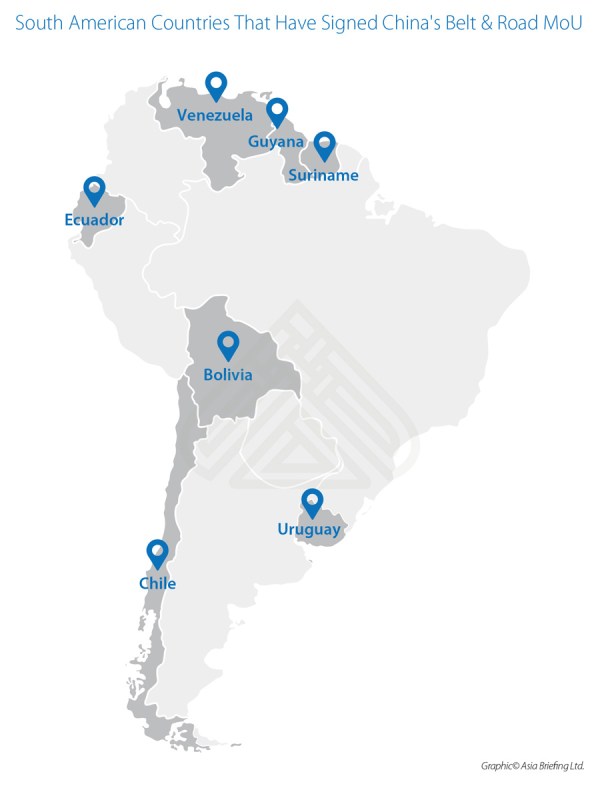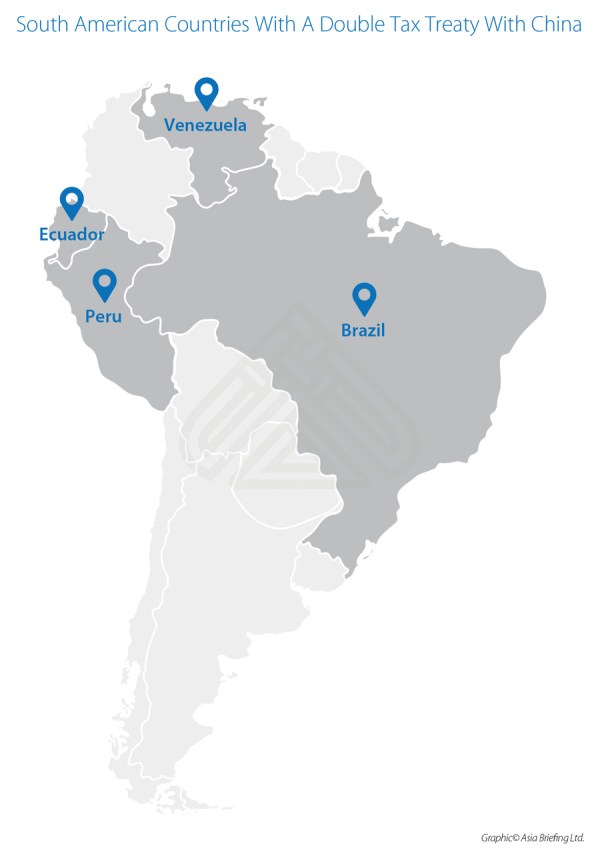China’s Belt & Road Initiative And South America
Op/Ed by Chris Devonshire-Ellis
China’s push into South America has not been quite as dynamic as its push into Africa, although it is gathering steam. As we have already noted in our Belt & Road articles on the Caribbean and Central America, part of the Belt & Road drive in the region has been to convert nations which recognize Taiwan as opposed to China. That is less of an issue in South America, nonetheless China’s Belt & Road Initiative push has been less dynamic here than elsewhere. At present, these are the South American nations that have signed off with China’s Belt & Road Initiative to date:

We already discussed Guyana and Suriname’s position in our Belt & Road Caribbean piece.
Of the South American countries, four also have a Double Tax treaty with China:

An FTA with Colombia is still at the feasibility study stage. This showcases that there is still a lot to be done to “sell” the Belt & Road to South American governments. There are issues: it could be that China is becoming quite stretched in its resources in terms of providing finance and loans to Governments in search of infrastructure funds, and has prioritized regions such as South-East and Central Asia and Africa, which are closer to home. South America, although undoubtedly rich in resources that China needs, will also be expensive. Infrastructure is poor, and the cost of opening that up significant. One suspects that China is leaving its Belt & Road ambitions in South America for a later stage in its global development.
That said, China has been active in the pursuit of diplomatic ties. Is has formed the China-CELAC Forum which brings together under a formal banner, China, together with the Community of Latin America and Caribbean States (LAC). The South American members of this include Argentina, Belize, Bolivia, Brazil, Chile, Colombia, Ecuador, Paraguay, Peru, Paraguay & Venezuela. The China-Celac Forum serves as a stage for dialogue and agenda-setting between international and regional leaders, and has become a Chinese priority as a push for deeper influence within the region, and by some to reduce the significant influence of the United States on the politics and economics of Latin America. China’s influence on the region has been accelerating fast. The value of trade between Latin America and China increased 22-fold between 2000 and 2013. China is LAC’s second largest source of imports, and the third largest market for LAC exports. China has recognized this in the second Chinese Policy Paper on LAC (2016), a cooperation trade network and investment review that leans towards the identification of energy and resources with new targets including the now Belt & Road familiar construction, agriculture, manufacturing, scientific and technological innovation. This fits in with countries such as Bolivia, Chile and Peru, as their economic profiles are built on national mineral wealth leading their domestic and foreign policies.
China is also interested in developing stronger trade ties with the Mercusor Bloc of Brazil, Argentina, Paraguay and Uruguay which have a common FTA between them. Venezuela is also a member but has been suspended since 2016, while Bolivia is an Associate member and not fully integrated. That said, discussions are taking place between China and the Mercusor nations over upgrading trade relationships to Free Trade status, although China seems to want to arrange this on a “step by step” basis according to comments made by China’s Foreign Minister Wang Yi when meeting with the Uruguayan Foreign Minister Nin Ninova at the beginning of last year. Again, China does not seem to be in too much of a hurry – “step by step” is probably an allusion to “one at a time” rather than a full China-Mercusor FTA. However the Mercosur bloc is significant, being the world’s fourth largest with a population of 260 million and accounting for 75% of South America’s GDP. China’s trade with Mercusor totaled about US$107 billion in 2018.
China has already stated its intentions to double bilateral trade with South America to US$500 billion by 2025 and to increase total investment into the region to US$250 billion.
On the ground, and of the South American countries that have signed off on China’s Belt & Road, Bolivia and Peru are being linked together via improved rail connections; as mineral production from Bolivia may be then exported to China through Peruvian ports. China’s COSCO appears to be facilitating this as it has purchased a 60% controlling stake in the Chancay terminal in the North of Lima for US$225 million. This is the first operation in Latin America for COSCO, which is already well known via its acquisition in the EU of the Greek Port of Piraeus.
China is also funding a number of major Argentinian infrastructure projects, including two nuclear plants and a US$2.5 billion upgrade of its main cargo rail network.
In Chile, China is providing an underwater, Fibre-Optic network linking the two countries together. It will be the first underwater fiber optic cable to directly connect Asia with Latin America and would help drive interconnectivity, trade, investment, as well as scientific and cultural exchanges between two continents. The cable begins in the Chilean city of Valparaiso, passing New Zealand, Australia and French Polynesia to connect with Shanghai and beyond.
Ecuador joined the Belt & Road Initiative last December, and immediately agreed a US$900m loan from China, a further US$69.3m for “reconstruction”, and received US$30m in “non-refundable assistance”.
Uruguay and China meanwhile are collaborating in the Uruguayan fishing industry, food processing and logistics, using the Belt & Road primarily in terms of agricultural cooperation.
Rather like Central America, whose countries face being excluded from trade with the US due to trade issues concerning minimum wages, South America may also start to turn its trade face more towards China. That however will probably mean concessions will need to be made. China has already committed significant financial and infrastructure resources into Africa, and chewing off two continents at the same time is too much of a financial stretch even for Beijing’s pockets. The hot regional spots continue to be further north around the Panama canal, while at present it appears China is still evaluating where in South America the low hanging fruit is easiest reached. Attention to when new Free Trade Agreements with China are signed off in the next few years will provide the relevant clues. However, this doesn’t have to get in the way of trade. China is still a growing consumer market, and Chinese tourists are gaining more confidence in their international travels. South America may be some way off for the type and sheer scale of Belt & Road investments that have taken off elsewhere, however a increasingly protectionist United States and a resurgent China are changing the dynamics of South America. Attention to Chinese business practices and the opportunities that exist with both Chinese investments, and China trade with South American businesses should not be underestimated.
About Us
Silk Road Briefing is written by Dezan Shira & Associates. The practice assists foreign investors into China and Asia, and has 28 offices throughout the region. We have a portfolio of clients from South America. For assistance please contact us at china@dezshira.com or visit us at www.dezshira.com
 Related Reading:
Related Reading:
![]() China’s Silk Road Gold Fund – The African and South American Gold Deposits (Part 3 of a 5 Part Series)
China’s Silk Road Gold Fund – The African and South American Gold Deposits (Part 3 of a 5 Part Series)
![]() China’s Demand for Resources Brings Brazil Closer
China’s Demand for Resources Brings Brazil Closer
![]() Venezuelan President’s Visit to China Indicative of Growing Sino-Latin American Trade and Opportunities
Venezuelan President’s Visit to China Indicative of Growing Sino-Latin American Trade and Opportunities






